Injury and Condition Modification Guide
By Jasmine Chehrazi, E-RYT 500, Certified Yoga Therapist
Whether you have low back pain, are pregnant, are bipolar or have any other injury or condition, even if you are cleared to practice yoga by your health care professional there are some things you need to keep in mind when practicing in a group yoga class at Yoga District or any studio:
1. Listen to your self: Do not do any movements or practices that hurt or make you feel strained, regardless of what any teacher says to you or the class. If you can’t maintain steady breathing in a pose, that’s a pretty good signal to change something.
2. Accept the limits of group instruction: Group classes are not appropriate settings for you to receive customized, therapeutic advice on how to treat your injury/condition with yoga. So if you have an injury/condition, try a private yoga therapy session instead.
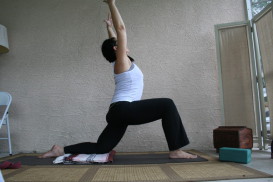
3. Avoid areas of pain: If you have a physical ailment in a certain area of the body, you may wish to avoid poses that involve that area entirely during group yoga classes. Instead, try focusing on poses that help strengthen and stretch surrounding areas. For example, if you have knee pain, you may benefit from strengthening and stretching the quads, hamstrings and other nearby muscles to help possibly relieve pressure on the knee joint. Or if you have back pain, you may benefit from engaging the abdominal muscles and stretching the hips and shoulders.
4. Ease out, decrease duration and increase repetition: Don’t go as “deeply” into a pose. For instance, in a forward fold try to focus on lengthening the spine rather than folding deeply into the bend. You can also choose to hold any pose for a shorter period of time, regardless of what the teacher cues. You may also benefit more by repeating a posture a few times, holding it for just a breath or two each time you repeat it.
5. Evenly distribute weight and try padding: Decrease pressure on any one part of the body by distributing weight more evenly to more points, and consider using a blanket for padding. For instance, in lunge pose, ground the back knee to distribute weight more evenly and, if desired, place a blanket under the back knee (see picture above right).
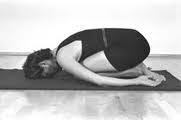
6. Find a safe resting pose: Some instructors offer child’s pose (see picture below right) as a resting pose but if this puts too much pressure on your hips, neck, ankles, knees, or any other part of the body, just pick any other comfortable, sustainable position you like. You should feel free to return to your resting pose at any time during a group yoga class, no matter what the teacher says. A successful practice is a safe one!
Here are some general ideas about modifying types of yoga poses, but please remember none of this constitutes medical advice and that you are practicing at your own risk:
– Back issues: Consider slightly bending your knees in all forward folding poses, engaging your abdominal and seat muscles throughout your practice, and keeping an elongated spine. Entirely avoid or avoid undue depth in back bends, forward folds or any other poses that could agitate the back.
– Knee issues: Avoid “locking” the knee joint, try to engage the muscles around the knee, and always keep each of your knees pointing in the same direction as the second and third toes of each foot. Try bending the ankle to 90 degrees to engage muscles around the knee, preventing unnecessary knee pressure. In standing poses, you can keep the back knee straight or on the ground (perhaps with a blanket cushioning the knee). The front knee in standing poses can be straight (but not “locked”), softly/slightly bent, or bent directly above your ankle (and never beyond the ankle), but always tracking with the second and third toes.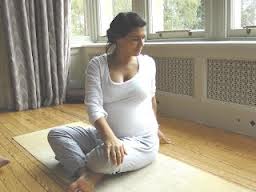
– Prenatal: Avoid laying on the back or stomach but laying on the left side is appropriate for many. Widen the distance between the feet and point the toes out about 45 degrees when standing or when doing a forward fold. The hormone “relaxin” is secreted during pregnancy and can increase your flexibility, so ensure you remain in control while stretching and avoid over-stretching. In twisting poses, ensure nothing (including your leg or legs) is in the way of the abdomen, and try to keep the naval pointing forward by twisting from the chest upwards. You may wish to gently engage the abdominals and focus on hip opening poses and breathing. Avoid balancing poses if you are prone to dizziness. If nauseous, avoid any posture in which the head is lower than the heart.
– Arthritis: Move slowly, focus on range of motion instead of speed of motion, and consider avoiding the more fast-paced types of yoga including “vinyasa” / “flow” classes. Try Gentle Yoga, Alignment-Focus Yoga, Restorative Yoga and other nicely paced classes.
– Menstruating: Avoid inversions where the hips are above the heart. Please take this seriously, as some link cervical cancer to reversal of menstrual flow (which could happen when you’re upsidedown in headstand and other inversions). Consider replacing downward facing dog with table position (on hands and knees), and consider replacing shoulderstand or headstand with “legs up the wall” pose. Hip openers and restorative practices may be particularly soothing.
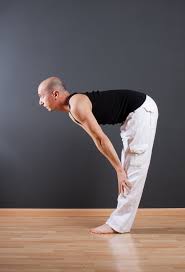
– High blood pressure (unmedicated or under-medicated): Consider avoiding all inversions (any pose where the head is lower than the heart), avoid holding your breath, pause whenever your breathing is not steady and slow, and avoid fast changes in elevation in relation to the heart and head (don’t quickly move from laying down to standing up).
– Headaches or migraines: Explore the same practices described for high blood pressure above.
– Low blood pressure: Avoid going from an inversion (any pose where the head is lower than the heart) to an upright position quickly, or at all. For instance, move from standing forward fold to standing slowly, or avoid the inversion of standing forward fold by replacing it with half forward fold (see picture right), keeping the torso parallel to the ground.
– Sinus pressure / congestion: Try the same practices explored for low blood pressure. Consider a supported inversion such as downward facing dog with a block under the forehead, or supported bridge pose. Avoid classes with quick transitions between inversions and upright positions, such as some vinyasa flow classes.
– Wrist pain: Avoid weight bearing on the wrists entirely. You can practice poses like downward facing dog, plank, and cobra by placing the elbows and forearms on the ground with the palms facing down (see picture below right).
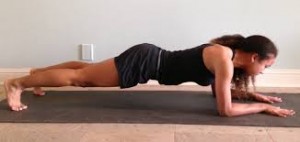
– Neck pain: Keep your head neutral / in line with the spine and avoid collapsing into the neck by engaging the neck muscles gently. Avoid turning your head while the neck is weight bearing, or avoid turning it entirely. For instance, in triangle pose you could keep your gaze downward or straight ahead rather than upward. Consider avoiding poses in which you could accidentally put pressure on the neck such as bridge, shoulderstand, fish and plow.
– Anxiety: Engage a vigorous practice, but avoid overly fast-paced movements and fast-paced breathing exercises if they agitate you. Focus on the exhales when concentrating on the breath. Be careful with backbends – approach them slowly, hold them for short periods of time when you’re first getting used to them, and perhaps try supported backbends to start. Explore yoga classes that feature set sequences if knowing what comes next puts you at ease. 
– Depression: Engage a vigorous practice, avoiding overly slow-paced classes. Try light, well-paced classes such as vinyasa flow styles. Consider engaging backbends, and focus on your inhales when concentrating on the breath. Avoid holding savasana (pictured right, the resting pose at the end of most yoga classes) longer than ten minutes, and practice savasana with the eyes slightly open, yet restful, if this is an aide.
Remember that these are just broad ideas you might try out at your own risk. Please feel free to share your experiences applying any of these practices or ideas by commenting below.
Practice safely!
This information is part of the Yoga District teacher training manual and may not be copied or distributed without permission. (c) Yoga District 2014


It’s very effortless to find out any matter on net as compared to books, as I found this paragraph at this site.
I recently worked with a rotator cuff strain, and my teacher suggested a very modified down dog—more akin to a forward fold, but with the hands about a foot and a half in front of the feet with fingers tented on the ground. When that was too much, I just stayed in forward fold. I modified chaturanga, avoided wheel and headstand, and instead of reaching my arms above my head for sun salutations, kept hands in prayer. It’s been hard to refrain from the vigor and intensity of my usual practice, but in the end, my shoulder is finally on the mend.
Don’t wait for a teacher to ask the class about any injuries (or don’t be shy). Approach them before class so they know your modifications are purposeful. Chances are they’ll have helpful suggestions.
Namaste